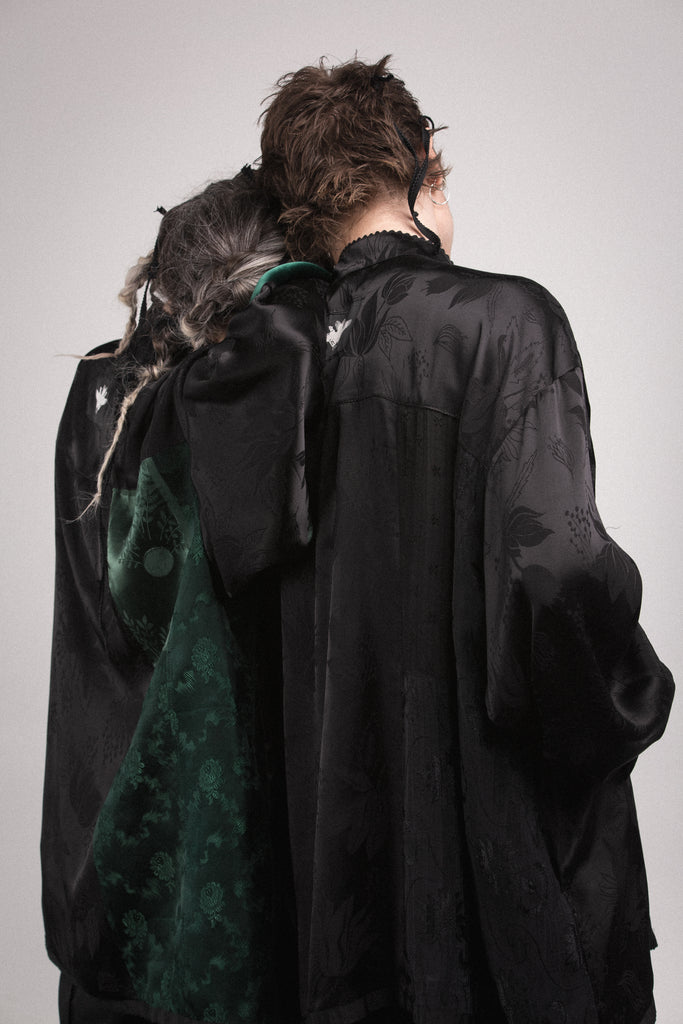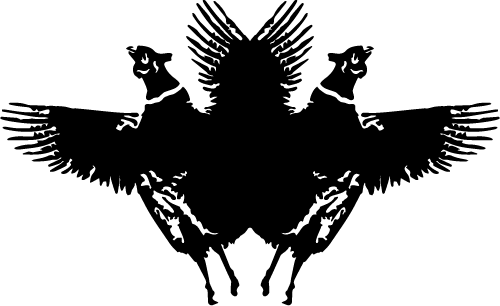
AW24 THREE DAYS LATER
Éva, Éva, don’t you go, dear child
They told me but I went
Oh how I wish I never left,
Aunty Éva said.
The story about the witches,
It’s too late now, it can’t be helped
But you ask, so I’ll tell.
~
It creeps up, the witching hour. You can lock the door but you can’t hide.
After midnight they come out. Their beds are cold, their bodies transformed. Animals, they are - but which ones?
Through the keyhole, through the walls the witches cross. Cursing, hexing, they cast their spells, but we also take revenge.
There was that man, you know the one. He was a witch but he came as a horse - nothing doing, he would not leave. At last, they caught it, and with a horseshoe it was branded. After that - the man’s hand was forever bandaged.
The trick is, now listen close, you use your left hand as you approach. That’s what I did, I remember well.
Into a chicken, she turned. That witch, that old hag.
So, I snapped the chicken’s head.
Three days later
The witch was dead.
ABOUT THE BRAND
Dora Zsigmond founded her eponymous brand in 2014 as a way of preserving fragments of the rapidly disappearing rural Hungarian culture. With the motto of “Inhale the past, exhale the future”, ZSIGMOND brings the disciplines of pre-fast-fashion garment-making back into contemporary design. The resulting pieces are gender neutral in nature, dark in aesthetics, and entirely unique in execution.
Less than 10 years into the brand’s existence, ZSIGMOND pieces have been acquired by the Museum of Applied Arts Budapest. Described by Forbes reporter Hiroyuki Anzai as “the direction where the luxury created by the new generation is headed”, the brand’s garments also got into stores in Berlin, Milan, Rome, Tokyo, Shizuoka, New York, Portland, Boston, Ontario, Gothenburg, Copenhagen, Valencia, Moscow, Perm and Krasnoyarsk.
Each ZSIGMOND collection consists of three lines. The all-black CORE collection of essential pieces and the REMADE line crafted from upcycled vintage fabrics are continuously present throughout the year, while the biannual seasonal collections are available for limited time periods.
ABOUT THE COLLECTION
In an homage to rural lore, the AW24 collection is inspired by word-of-mouth stories passed down from one generation to the next. The catalyst of THREE DAYS LATER is an elderly lady, who shares her encounters with witches from her home in the Hungarian village of Decs. Her disjointed account of the events paints a vivid picture of the paradox inherent to folklore. The tales of witches are as unsettling as they are tranquil in their unquestioning acceptance of death as part of life, of witchcraft as part of nature. As she’s sitting there with her white hair tucked under a headkerchief, she might not remember it all, but she is certain of one thing: there is truth in every story once they have been told.
The collection takes its visual cues from witchcraft: gray smoke swirls as green and purple poisons brew in large cauldrons between moss-covered trees, all safely hidden behind the black veil of the night. The textures alternate in harmony; from velvet to fluid, soft to rigid, smooth to blistering, the fabrics envelop their wearer in a tactile experience.
PRINTS
The prints are inspired by stories of witchcraft as told by an elderly lady from rural Hungary. The focal point of the recounted events is transformation: when the witching hour comes, the wicked morph into animals to freely roam and curse the villagers. Doors were locked in vain, for witches could creep through keyholes. Some of them turned into chickens, while another tale details an encounter that ended in retaliation. The witch turned into a horse; the horse was caught and shoed, and the man - he had then worn a bandage around his hand for the rest of his life.
The prints were designed by Hungarian artist and tattooist Aron Dimen, and screen-printed onto the garments by hand in an independent workshop in Budapest.
SUSTAINABILITY
Every ZSIGMOND piece is produced locally and ethically in Hungary.
Each fabric is certificated and sourced exclusively from qualified, European manufacturers. Natural materials like brass and ethically collected horn replace plastic fasteners to minimize plastic pollution.
The REMADE line upcycles 60 to 100-year-old traditional textiles acquired from the countryside of Hungary.
The designs follow zero-waste principles focusing on angular silhouettes that waste less fabric and incorporate the selvedge of textiles. Leftover fabrics are utilized in the SALVAGE line of accessories.
Patterns are screen-printed by hand in Budapest using a unique, eco-conscious dye.
Hem facings are used on sleeves, collars and hemlines to strengthen the garments’ durability and longevity.
Hand-craft and traditional garment-making techniques are incorporated to preserve heritage, while practical elements like waterproof materials, detachable sleeves and hoodies, adjustable sizing and reversible designs further the garments’ versatility.
Giving back to the community and supporting independent workshops, artists, manufacturers and craftsmen are an important part of the brand’s approach to a sustainable future.
Fabric innovation is part of ZSIGMOND’s long-term proposition with experiments focusing on recycling and upcycling.
REMADE
The REMADE line upcycles 60 to 100-year-old traditional textiles collected from the countryside of Hungary. The designer, Dora and her brother, György spent close to two decades getting to know villagers from all over the country and building deeply personal connections with them. These traditional garments and household items safekept mainly by the elderly are revered not only for their intricate craftsmanship but often for the stories and profound emotions attached to them. Thus, acquiring these pieces requires the trust of the villagers and, in turn, an understanding of their value - both tangible and intangible.
The Zsigmond siblings preserve these culturally significant pieces for the future through their private collection and the REMADE line, which reinterpret them in a contemporary context.
SALVAGE
Following zero-waste principles, our SALVAGE line of accessories repurposes leftover fabrics from previous collection. The handmade pieces are created using a unique knot-crochet technique, which was often used in rural Hungarian homes to salvage old, worn-out clothing in the forms of household items like rugs.
CREDITS
photo: Péter Lestár
creative concept: Dóra Zsigmond
models: Todo at Visage I Gabi at Visage I Christian at Visage I Balázs at Icon I Laura Hergovics I Olivér Rakovszky I György Pálffy I Áron Dimén
hair: Andris Bálint I Bence Poltl
makeup: Bori Illényi-Házi
body paint: Áron Dimén
vegetation: György Zsigmond _ Finecut
creative writing: Krisztina Tar
graphic design: Dóra Zsigmond
production assistants: Kitti Szuhai I Andrea Vandornyik I Györgyné Zsigmond
















